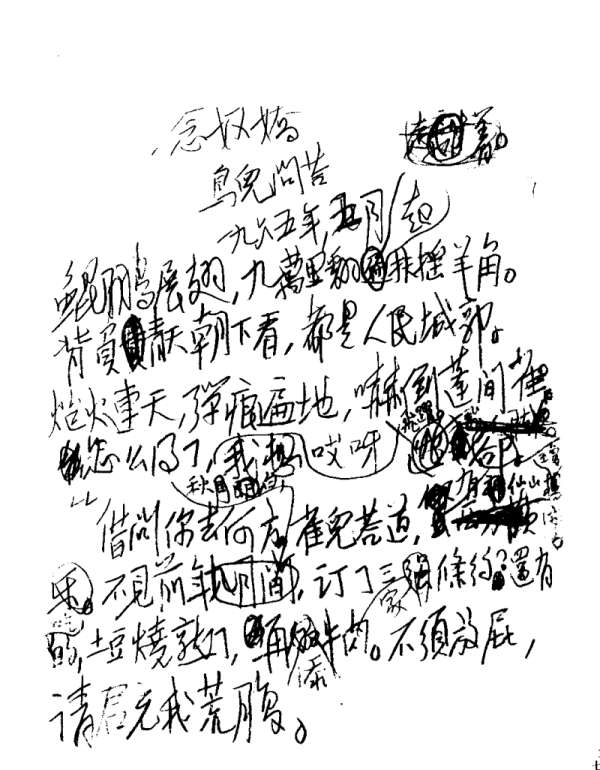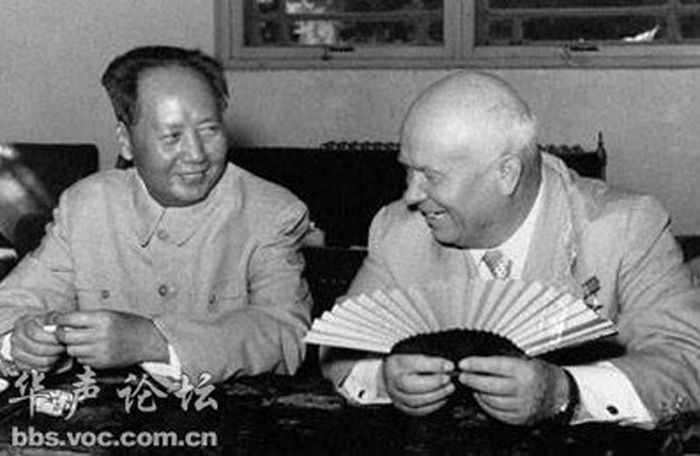
毛主席诗词
念奴娇·鸟儿问答
一九六五年秋
Two Birds: A Dialogue
To the tune of Nian Nu Jiao
Autumn 1965
鲲鹏展翅,
九万里,
翻动扶摇羊角。
背负青天朝下看,
都是人间城郭。
炮火连天,
弹痕遍地,
吓倒蓬间雀。
怎么得了,
哎呀我要飞跃。
借问君去何方,
雀儿答道:
有仙山琼阁。
不见前年秋月朗,
订了三家条约。
还有吃的,
土豆烧熟了,
再加牛肉。
不须放屁!
试看天地翻覆。 |
The roc wings fanwise,
Soaring ninety thousand li
And rousing a raging cyclone.
The blue sky on his back, he looks down
To survey Man's world with its towns and cities.
Gunfire licks the heavens,
Shells pit the earth.
A sparrow in his bush is scared stiff..
"This is one hell of a mess!
O I want to flit and fly away."
"Where, may I ask?"
The sparrow replies,
"To a jewelled palace in elfland's hills.
Don't you know a triple pact was signed
Under the bright autumn moon two years ago?
There'll be plenty to eat,
Potatoes piping hot,
Beef-filled goulash."
"Stop your windy nonsense!
Look, the world is being turned upside down."
|

原诗草稿
【注释】
鸟儿问答:《庄子·逍遥游》,“有鸟焉,其名为鹏,背若泰山,翼若垂天之云,抟扶摇羊角而上者九万里,绝云气,负青天,然后图南,且适南冥也。斥鷃笑之曰:‘彼且奚适也,我腾跃而上,不过数仞而下,翱翔蓬蒿之间,此亦飞之至也,而彼且奚适也。’”昆鸡:鸟名,黄白色,长颈赤嘴。
三家条约:指美英苏三国签署的部分禁止核试验条约。
土豆、牛肉:六四年四月访问匈牙利时,苏共领导赫鲁晓夫曾说,共产主义就是人人有土豆牛肉汤喝。


************************* NOTE ON THE VERSE FORM of MAO ZEDONG POEMS:*******************************
All the poems in this volume are written in classical Chinese verse forms. Those which carry the subtitle "to the tune of . . . " belong to the type of verse called tzu. The rest are either lu or chueh, two varieties of the type shih.
The tzu originated in the Tang Dynasty (A.D. 618-907) as lines sung to certain tunes. Each tune prescribes a strict tonal pattern and rhyme scheme, with a fixed number of lines of a standardized varying length. Names like Chin Yuan Chun, Pu Sa Man, etc. indicate not the themes of the respective poems but the tunes to which they are written.
Lu and chueh are the two forms of the shih, which, after inchoate beginnings in preceding ages, became fully established in the Tang Dynasty. With a strict tonal pattern and rhyme scheme the lu or lu shih consists of eight lines of either five or seven characters each; the third line should be matched to the fourth and the fifth to the sixth in both sound and sense. The lu shih in this volume are of the seven-character kind. The chueh or chueh chu consists of four lines of either five or seven characters each. It is a sort of truncated lu, but the third and fourth lines, though still counterpointed in sound, need not be antithetical in sense. The chueh chu in this volume are of the seven-character kind.

|





